You thought Carnival was over with the sprinkling of the ashes on penitential hairdos? Not quite.
Carnival doesn’t slink away under cover of darkness when the marangon, the basso profundo bell in the campanile of San Marco, tolls midnight on Martedi Grasso. Two things have to happen for it to really be over — in my opinion, that is. Two things which are more predictable than the swallows returning to Capistrano.
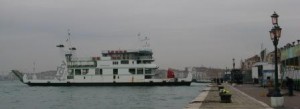
The first is the pulling apart and hauling away of the traveling amusement park (what they generically call a “Luna Park” here) which has been gracing the Riva dei Sette Martiri since — I believe — early December.
These people (as in much of the world) are almost exclusively families which have dedicated many generations to the setting up, operating, pulling down, and rolling on to the next location of their ride or concession stand.
After three months, I’m going to miss the smell of the hot-doughnut-frying-oil and the screeching of the children. It was fun strolling along the waterfront late every afternoon to mingle and kibitz. And I am convinced that as long as there is at least one small child walking home carrying a small plastic bag containing water and a goldfish, the world will not come to an end.
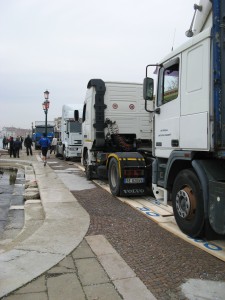
Anyway, the men start work early on Ash Wednesday morning, and by Thursday morning the funfair is gone. The only sign they’ve ever been here are the patches of new cement filling the holes in the pavement where their big rigs (or something) went astray.
Speaking of itinerant carnies, I went to the small town of Bergantino a few years ago when I was working on a story about the Po River (National Geographic, May, 2002). This former farming town has, since the Twenties and much more since the Sixties, become dedicated to the design, construction, and (eventually) operation of carnival rides — merry-go-rounds, bumper cars, etc. Despite the town’s modest size — it’s really just a village of some 2,000 people, when they’re all there, I mean, and not out on the road — they’ve carved away a heavy slice of this international industry for Italy. One of the major markets for their inventions is the USA.
Well, wherever they’ve gone, I’m already missing them.
The second element of the end of Carnival is the orgy of articles, editorials, and letters in the Gazzettino reviewing, celebrating, and vilifying the festivities just concluded. I can tell you without even having opened the paper that there will have been too many people for this fragile city to support; that the managing of this predictable overload will have shown inexcusable organizational flaws and failures to resolve the most elementary large-event necessities (toilets, in a word); that the money taken in doesn’t justify the stress and expense to the city; that it will have lacked originality and creative genius, and that for the residents and shopkeepers of Campo Santa Margherita, the ten days just concluded have been nothing less than at least six of the nine rings of hell.
And every year, the apex of all the claims and counter-claims: That this event would be (or ought to have been, or next year definitely will be) the “Carnival of the Venetians.” I saw Venetians having a fine time carnivalizing in their own modest way in various neighborhoods of the city, but not in the Piazza San Marco. I’d have given you a cash prize if you’d found any Venetians besides Lino in the Piazza San Marco.
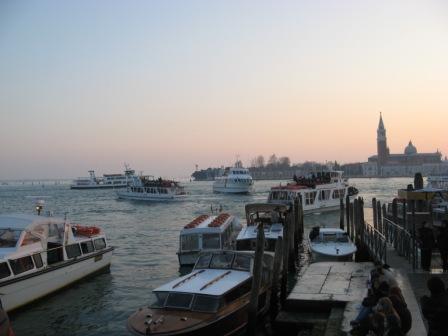
So when this wish to involve Venetians is mentioned, as if it were obviously a good thing, I ask myself if the speaker believes that a “Carnival of the Venetians” would have the slightest probability of pouring the millions of euros into the municipal strongboxes that all those tourists do. After all, Venetians don’t spend money on hotel rooms, restaurant meals, fancy masks, or whatever else makes Carnival matter. So frankly, what would be the point of spending money to organize a ten-day carnival for the few remaining locals? Just wondering.
Let’s go to the videotape (so to speak). Here is a smattering of the Gazzettino’s overview of Carnival 2010, as published yesterday:
The organizers claim that 150,000 people came the first Sunday; 250,000 the second Sunday (let that sink in…) and 40,000 on Martedi Grasso. Altogether, they say a total of 800,000 people came to Venice during Carnival. Perhaps not much compared to Rio, but for a city that covers a mere three square miles, not bad.
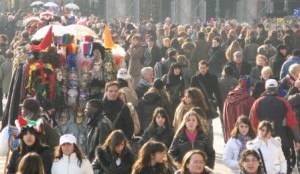
One new comment is by the businesspeople (especiallythose of restaurants and cafes) in the Piazza San Marco — they don’t want a maxi-stage there anymore. I’m not sure why, but I imagine it’s because it takes up too much space which needs to be available for them to put out their tables and chairs.
I could go on, but it’s probably not that interesting. These few days following Carnival are mainly spent in a sort of emotional and mental scrubbing and disinfecting.
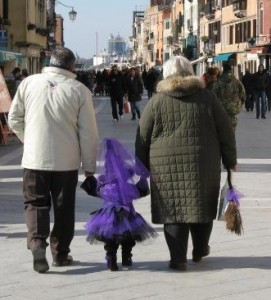
The summary is fairly concise. Apart from numbers, claims, and counter-claims as to success or failure, as one reporter wrote, “Now the Venetians can give a deep sigh of relief and put their hands on their foreheads and say, “‘Once again we’ve lived through it.'”
